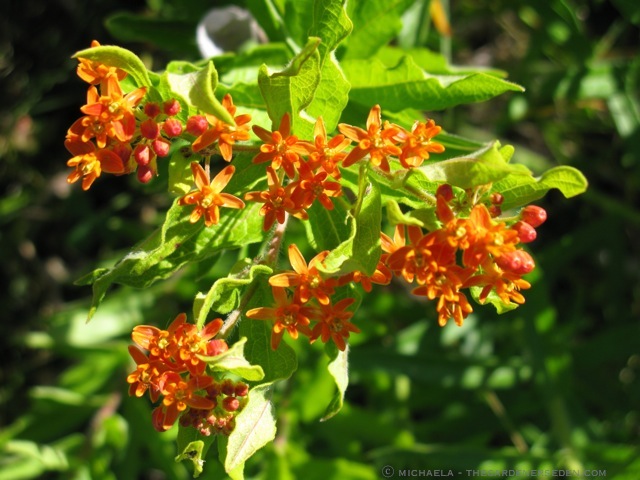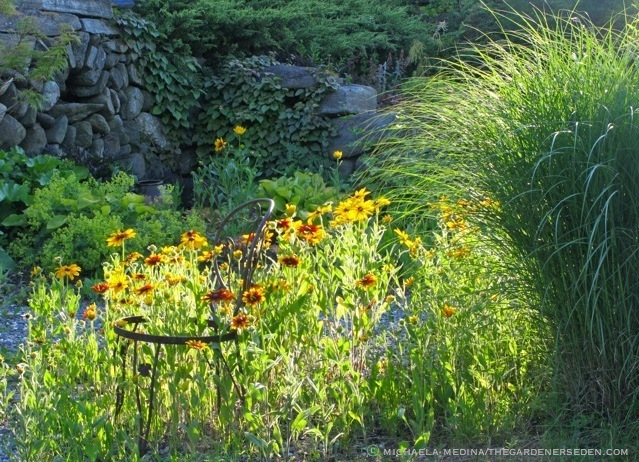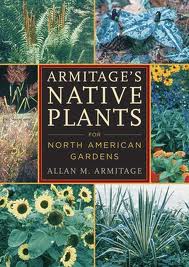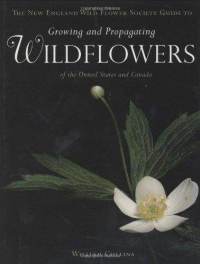Welcome, Pretty Papillon! Attracting Butterflies & Moths to the Garden
 Red-Spotted Purple Butterfly (Limenitis arthemis) in My Wildflower Meadow, Visiting Queen Anne’s Lace (Daucus carota)
Red-Spotted Purple Butterfly (Limenitis arthemis) in My Wildflower Meadow, Visiting Queen Anne’s Lace (Daucus carota)
 Tiger Swallowtail Butterfly (Papilio glaucus) on Lilac Blossoms (Syringa vulgaris ‘Mme. Lemoine’ ) in My Garden- Read More About This Lovely Butterfly in My Previous Post by Clicking Here.
Tiger Swallowtail Butterfly (Papilio glaucus) on Lilac Blossoms (Syringa vulgaris ‘Mme. Lemoine’ ) in My Garden- Read More About This Lovely Butterfly in My Previous Post by Clicking Here.
 Fritillary on Butterfly Weed (Asclepias tuberosa) – Read More About This Native Butterfly Magnet by Clicking Here
Fritillary on Butterfly Weed (Asclepias tuberosa) – Read More About This Native Butterfly Magnet by Clicking Here
Is there anything more magical than the first butterfly sighting of the year? Much as I delight in the beauty of horticulture, I must admit that even the most spectacular of flowers pales in comparison to the poetic papillon. And what gardener wouldn’t want to work surrounded by butterflies dancing on the wind? I can’t imagine a more delightful way to spend my days. Of course butterflies are more than just pretty, and while bees are recognized as the most effective pollinators of food crops, butterflies also perform an important role in the pollination of flowers. As this fascinating insect moves within each blossom —gathering nectar with its long, curled proboscis— the butterfly’s entire body —legs, head and wings— acts as magnet for dusty pollen, which is redistributed as it moves from one part of the flower to another; from blossom to blossom and plant to plant.
Watching beautiful butterflies and moths while they work their magic within flowers is easy, but for many gardeners it’s harder to appreciate these insects when they begin their lives as voracious caterpillars. Butterflies and moths undergo a complex life cycle from eggs to caterpillars, followed by metamorphosis to moths and butterflies. As gardeners, it’s important that we become familiar with the changing appearance of moths and butterflies in order to protect these insects in all of their life stages. Butterfly and moth caterpillars all eat plant foliage, and one of the keys to creating a healthy habitat for butterflies, is learning to accept less-than-perfect-looking plants. Avoid the indiscriminate use of all pesticides —including organic solutions like insecticidal soap and Btk— in order to protect young butterflies and moths. Spray only when you absolutely must, and be sure that you can properly identify an insect before pulling out the pesticide…
 The Bold Pattern and Bright Colors of the Monarch Butterfly Caterpillar (Danus plexippus) Make it Easy to Recognize as It Feasts on the Leaves of Butterfly Weed (Asclepias tuberosa). Learning to Accept and Tolerate Less-than-Perfect-Looking Plants is Key to Creating Healthy Habitat for Pollinators. In Addition to Adopting a More Tolerant Attitude Toward Chew-Marks, Provide Habitat in the Form of Wildflower/Wild Plant Areas. By Studying the Preferences of Butterflies, Soon You Will Come to See “Scrubby” Understory and Meadow Areas as Beautiful…
The Bold Pattern and Bright Colors of the Monarch Butterfly Caterpillar (Danus plexippus) Make it Easy to Recognize as It Feasts on the Leaves of Butterfly Weed (Asclepias tuberosa). Learning to Accept and Tolerate Less-than-Perfect-Looking Plants is Key to Creating Healthy Habitat for Pollinators. In Addition to Adopting a More Tolerant Attitude Toward Chew-Marks, Provide Habitat in the Form of Wildflower/Wild Plant Areas. By Studying the Preferences of Butterflies, Soon You Will Come to See “Scrubby” Understory and Meadow Areas as Beautiful…
 Later in Summer, the Adult Monarch Butterfly (Danus plexippus) Emerges from It’s Cocoon and Lights on Potted Butterfly Weed (Asclepias curassavica ‘Silky Red’).
Later in Summer, the Adult Monarch Butterfly (Danus plexippus) Emerges from It’s Cocoon and Lights on Potted Butterfly Weed (Asclepias curassavica ‘Silky Red’).
 Pretty Impersonator: The Viceroy Butterfly (Limenitis archippus) Lighting on Straw in My Potager Looks a Great Deal Like the Monarch Above, But It’s Actually a Different, Smaller Butterfly. Even the Viceroy Caterpillar Looks Quite Similar to the Monarch. Read More About and See More Photos of the Viceroy and other Species at the Incredible Butterflies and Moths Website by Clicking Here
Pretty Impersonator: The Viceroy Butterfly (Limenitis archippus) Lighting on Straw in My Potager Looks a Great Deal Like the Monarch Above, But It’s Actually a Different, Smaller Butterfly. Even the Viceroy Caterpillar Looks Quite Similar to the Monarch. Read More About and See More Photos of the Viceroy and other Species at the Incredible Butterflies and Moths Website by Clicking Here
As you begin to familiarize yourself with the caterpillars, butterflies and moths visiting your garden, you may notice that while they enjoy many plants and flowers, they are definitely more interested in certain species than others. Providing a continuous supply of food and fresh water —be sure to provide butterflies with a safe “island” such as a stick or other place to light to prevent drowning in water features— from early spring through late fall  —for both caterpillars, butterflies and moths— is the best way to attract and keep these lovely creatures in your garden. But it’s just as essential to consider the “big picture” of your landscape and neighborhood. Instead of viewing natural areas as “unkempt”, try thinking of them from the butterfly’s point of view. Understory shrubs, trees and wild grasses provide essential habitat for caterpillars and migratory butterflies. Wildflower meadows, swamps and emerging forests with tangled stands of birch and poplar trees are prime real estate for egg-laying butterflies. Consider the consequences before you mow in the name of “necessary” maintenance. Before you cut, ask yourself how much manicured space you really need.
Caterpillars rely upon the foliage of many native, deciduous and evergreen trees and shrubs, as well as herbaceous plants for sustenance. In addition to protecting natural areas, try planting some caterpillar favorites in your landscape. While each species has its own preferences, some of the most important larval hosts for moths and butterflies include the following native trees and shrubs (this list is by no means complete and is limited to North American plants), many of which also provide beautiful and beneficial flowers and/or fruits: Amelanchier (Serviceberry), Asimina (Paw Paw), Betula (Birch), Carya (Hickory), Carpinus caroliniana (American Hornbeam), Cassiope (Mountain Heather), Castanea (Chestnut), Ceanothus (California Lilac), Celtis (Hackberry), Crataegus (Hawthorn), Fagus grandifolia (American Beech), Fraxinus (Ash), Juglans (Walnut), Juniperus (Juniper), Malus (Crabapple), Pinus (Pine), Populus (Poplar), Prunus (Cherry and Plum), Quercus (Oak), Sassafras albidium (Sassafras), Ulmus (Elm), Arctostaphylos (Bearberry), Lindera benzoin (Spicebush), Myrica (Bayberry), Potentilla fruiticosa (Cinquefoil), Rhus (Sumac), Ribes (Gooseberry/Current), Salix (Willow), Sambucus (Elderberry), Vaccinium (Blueberry) and Viburnum.
 The Hummingbird Moth is a Member of the Sphingidae Family, Which Includes Hawk Moths, Sphinx Moths and Hornworms. The Hummingbird Hawk Moth, A Beautiful and Important Pollinator, Begins Life as Large, Green, Very-Hungry Caterpillar; Related to the Tomato Hornworm. If the Hummingbird Moth Appeals to You, Learn to Protect and Provide for Its Curious Caterpillar (Many Feed Upon the Leaves of Shrubs and Trees). The Hummingbird Moth Above (Hemaris thysbe ) was Photographed on Fragrant Abelia (Click Here for More on Abelia mosanensis). This Fantastic Flier Visits Many of the Same Flowers as Butterflies, Bees and True Hummingbirds. Learn More About the Hummingbird Moth by Clicking Here.Â
The Hummingbird Moth is a Member of the Sphingidae Family, Which Includes Hawk Moths, Sphinx Moths and Hornworms. The Hummingbird Hawk Moth, A Beautiful and Important Pollinator, Begins Life as Large, Green, Very-Hungry Caterpillar; Related to the Tomato Hornworm. If the Hummingbird Moth Appeals to You, Learn to Protect and Provide for Its Curious Caterpillar (Many Feed Upon the Leaves of Shrubs and Trees). The Hummingbird Moth Above (Hemaris thysbe ) was Photographed on Fragrant Abelia (Click Here for More on Abelia mosanensis). This Fantastic Flier Visits Many of the Same Flowers as Butterflies, Bees and True Hummingbirds. Learn More About the Hummingbird Moth by Clicking Here.Â
 North American, Native Amsonia illustris Attracts Hummingbird Moths, Butterflies and Bees. It’s Also A Beautiful Garden Plant, Offering Clear-Blue Blossoms in May, Fine-Textured Foliage Throughout Summer, and Clear, Golden Autumn Foliage. This Lovely Native —and Other Bluestar Species; Including Amsonia hubrichtii and A. tabernaemontana— are Frequently Featured Here as Fall Foliage Superstars.
North American, Native Amsonia illustris Attracts Hummingbird Moths, Butterflies and Bees. It’s Also A Beautiful Garden Plant, Offering Clear-Blue Blossoms in May, Fine-Textured Foliage Throughout Summer, and Clear, Golden Autumn Foliage. This Lovely Native —and Other Bluestar Species; Including Amsonia hubrichtii and A. tabernaemontana— are Frequently Featured Here as Fall Foliage Superstars.
 Hummingbird Moth (Hemaris thysbe) Gathering Nectar from Amsonia Blossoms. Read More About Hummingbird Moths by Clicking Here.
Hummingbird Moth (Hemaris thysbe) Gathering Nectar from Amsonia Blossoms. Read More About Hummingbird Moths by Clicking Here.
As adults, butterflies and moths are most attracted to cluster-flowers. In my previous posts on butterflies —including a post on my visit to Magic Wings Butterfly Conservatory with tips for attracting butterflies to gardens and an article on the top three plants for butterflies— many of these annual and perennial flowers are included. Mosy butterfly flower lists include Asclepias (Milkweed/Butterflyweed family); one of the most important, cluster-flowered, native butterfly plants. In addition to the non-native species listed in my previous posts, linked above —such as Verbena bonariensis and Butterfly Bush* (Buddleia davidii, *which is considered an invasive plant in some areas of North America, and therefore restricted)— there are many more, beautiful North American wildflowers and native, garden-worthy plants for pollinators.
Some of the best perennial wildflower choices for attracting butterflies and moths include the following: Actaea simplex (Cimicifuga/Fairy Candles/Black Cohash), Agastache (Wild Hyssop), Allium (Wild Onion), Amsonia (Bluestar, pictured above), Aruncus dioicus (Goat’s Beard), Ascelepias (Milkweed/Butterflyweed), Asters, Baptisia (Wild Indigo), Boltonia (False Aster), Campanula (Harebell), Castilleja (Paintbrush), Chelone (Turtle Head), Coreopsis (Tickseed), Dicentra (Bleeding Heart), Echinacea purpurea (Purple Coneflower), Epilobium (North Americn Native Fireweed), Eupatorium (Joe Pye Weed), Filipendula rubra (Queen of the Prairie), Gaillardia (Blanket Flower), Gaura, Geranium (Wild Geranium and cultivars), Helenium autumnal (Sneezeweed), Helianthus (Sunflower), Heliopsis (Oxeye), Hibiscus, Liatris (Blazing Star), Lilium (Lily), Lobelia, Lupinus (Lupine), Monarda (Beebalm/Bergamot), Penstemon (Beard’s Tongue), Phlox, Physostegia virginiana (False Dragonhead), Polemonium (Jacob’s Ladder), Polygonatum (Solomon’s Seal), Rudbeckia (Coneflower/Black-Eyed Susan), Salvia (Sage), Sedum (Stonecrop), Solidago (Goldenrod), Tiarella (Foam Flower), Verbena, Veronia (Ironweed), Viola (Violets), and Yucca (Soapweed).
In addition to providing perennial flowers, plant cluster-flowering annuals in garden beds and containers to maintain a steady supply of nectar for butterflies and moths…
 Cluster Flowers are Particularly Attractive to Butterflies. Pictured Here is Asclepias tuberosa, Native, North American  Butterfly Weed. (Read More Here). Try Supplementing Perennial Cluster Flowers with Those of Annual Plants like Verbena bonariensis.
Cluster Flowers are Particularly Attractive to Butterflies. Pictured Here is Asclepias tuberosa, Native, North American  Butterfly Weed. (Read More Here). Try Supplementing Perennial Cluster Flowers with Those of Annual Plants like Verbena bonariensis.
 Plants Blooming at the Beginning of the Continuum —Very Early Spring, When Food Supplies are Limited— are of Great Importance to Returning Pollinators. North American Native Labrador Violet is a April/May-Blooming, Early Butterfly Favorite. Read More About this Fantastic, Ground-Cover for Shady Places by Clicking Here.
Plants Blooming at the Beginning of the Continuum —Very Early Spring, When Food Supplies are Limited— are of Great Importance to Returning Pollinators. North American Native Labrador Violet is a April/May-Blooming, Early Butterfly Favorite. Read More About this Fantastic, Ground-Cover for Shady Places by Clicking Here.
 Later On in the Year, Mid-Late Season Flowers Provide and Important Source of Sustenance to Butterflies and Moths as They Emerge from Their Cocoons. Many Gardeners Shop for Plants in Late May and Early June, Purchasing Plants Like Peonies and Roses. Lovely as the May/June Bloomers are, to Attract and Keep Butterflies, the Gardener Must Provide Season-Spanning Bloom. Later-Season Flowers like the Rudbeckia hirta (Black-Eyed Susan) —pictured above in my wildflower walk above— as well as Echinacea, Sedum, Eupatorium, Actaea simplex, Solidago, Helenium and Asters are Key to Providing a Steady Supply of Nectar for Butterflies. Read More About Oli’s (My Dog) Accidental Wildflower Walk, by Clicking Here.
Later On in the Year, Mid-Late Season Flowers Provide and Important Source of Sustenance to Butterflies and Moths as They Emerge from Their Cocoons. Many Gardeners Shop for Plants in Late May and Early June, Purchasing Plants Like Peonies and Roses. Lovely as the May/June Bloomers are, to Attract and Keep Butterflies, the Gardener Must Provide Season-Spanning Bloom. Later-Season Flowers like the Rudbeckia hirta (Black-Eyed Susan) —pictured above in my wildflower walk above— as well as Echinacea, Sedum, Eupatorium, Actaea simplex, Solidago, Helenium and Asters are Key to Providing a Steady Supply of Nectar for Butterflies. Read More About Oli’s (My Dog) Accidental Wildflower Walk, by Clicking Here.
In addition to providing habitat and caterpillar forage, flowering trees and shrubs also provide sustenance to adult pollinators of all kinds. Again, butterflies and moths are particularly attracted to cluster-flowering species, including many fruit and berry producing plants. Some of the best North American natives, “nativars” and hybrids in this group include the following: Aesculus and A. parviflora (Buckeye Trees and Bottlebrush Buckeye shrub), Arctostaphylos (Bearberry), Callicarpa (Beautyberry), Castanea (Chestnut), Clethra (Sweet Pepperbush/Summersweet, pictured below), Cornus (Dogwood trees and shrubs), Crataegus (Hawthorn), Diervilla lonicera (Native Bush Honeysuckle), Diospyros (Persimmon), Gleditsia triacanthos (Honeylocust), Gymnocladus dioicus (Kentucky Coffeetree), Fothergilla (Witch Alder, pictured below), Halesia (Silverbell), Hamamelis (Witch Hazel), Hydrangea (Wild and Cultivated),  Hypericum (St. John’s Wort), Ilex (Holly), Itea virginica (Virginia Sweetspire), Kalmia (Mt. Laurel), Leucothoe, Lindera benzoin (Spicebush), Malus (Apple), Nyssa (Tupelo), Philadelphus (Mock Orange), Physocarpus opulifolius (Eastern Ninebark), Pieris (Andromeda), Potentilla fruiticosa (Cinquefoil), Prunus (Cherry and Plum), Rhododendron (Azalea), Rhus (Sumac), Rubus (Raspberry/Blackberry), Salix (Willow), Sassafras, Sambucus (Elderberry), Sorbus (Mountain Ash), Spirea alba (Meadowsweet), Stewartia, Styrax (Snowbell), Ulmus (Elm), Vaccinium (Blueberry/Cranberry), and my favorite, Viburnum…
 Perfect for Early-Season Pollinators (April/May) and Late-Season Color (October/November), North American, Native Fothergilla (Pictured here: Fothergilla major ‘Mt. Airy’) is One of My Favorite Plants. Read More by Clicking Here. For Smaller Gardens, Consider Dwarf Witch Alder (Fothergilla gardenii and the Fabulous Blue-Leaf Cultivar F. g. ‘Blue Shadow’)
Perfect for Early-Season Pollinators (April/May) and Late-Season Color (October/November), North American, Native Fothergilla (Pictured here: Fothergilla major ‘Mt. Airy’) is One of My Favorite Plants. Read More by Clicking Here. For Smaller Gardens, Consider Dwarf Witch Alder (Fothergilla gardenii and the Fabulous Blue-Leaf Cultivar F. g. ‘Blue Shadow’)
 Horse Chestnut Blossoms are Popular with Butterflies, Moths, Hummingbirds and Bumblebees. Read More About this Gorgeous Cultivar ‘Ft. McNair’ by Clicking Here
Horse Chestnut Blossoms are Popular with Butterflies, Moths, Hummingbirds and Bumblebees. Read More About this Gorgeous Cultivar ‘Ft. McNair’ by Clicking Here
 Wonderfully Fragrant, Late-Season Bloom and Gorgeous, Golden Fall Foliage Make Clethra alnifolia (Summersweet/Sweet Pepperbush) a Favorite withBees, Hummingbirds, Moths, Late-Season Butterflies and Knowledgable Gardeners, Alike. Such Beauty in July/August Makes Up for Her Scruffy, Springtime Appearance. She’s a Bit of a Late Sleeper, That’s All! Read More About the Wonderful, Native Clethra alnifolia by Clicking Here
Wonderfully Fragrant, Late-Season Bloom and Gorgeous, Golden Fall Foliage Make Clethra alnifolia (Summersweet/Sweet Pepperbush) a Favorite withBees, Hummingbirds, Moths, Late-Season Butterflies and Knowledgable Gardeners, Alike. Such Beauty in July/August Makes Up for Her Scruffy, Springtime Appearance. She’s a Bit of a Late Sleeper, That’s All! Read More About the Wonderful, Native Clethra alnifolia by Clicking Here
For more information about butterflies and moths, including ID keys, I suggest visiting the Butterflies and Moths website, butterfliesandmoths.org, by clicking here. For more information about wildflowers and other native plants, check out some of the resources in this post. And to learn more about gardening with butterflies in mind, check out some of the books below at your local library, bookstore, or linked online source.
Enjoy the beauty of the poetic papillon and help protect their future!
 Eastern Tiger Swallowtail on Syringa vulgaris ‘Mme. Lemoine’ in My Vermont Garden. Click Here for More Information on the Tiger Swallowtail Butterfly.
Eastern Tiger Swallowtail on Syringa vulgaris ‘Mme. Lemoine’ in My Vermont Garden. Click Here for More Information on the Tiger Swallowtail Butterfly.
 Sally Roth’s Attracting Butterflies & Hummingbirds to Your BackyardÂ
Sally Roth’s Attracting Butterflies & Hummingbirds to Your BackyardÂ
 Allan Armitage’s Native Plants for North American Gardens
Allan Armitage’s Native Plants for North American Gardens
 William Cullina’s Wildflowers
William Cullina’s Wildflowers
Watch the Complete Life Cycle of a Monarch Butterfly by Clicking the Link Above. A Duncan Scott Film Produced for the Chicago Nature Museum in Chicago, IL (If You Have Trouble Viewing the Video, Click on This Direct YouTube Link). Film Copyright Duncan Scott, All Rights Reserved.
This post was originally published by The Gardener’s Eden, June 4, 2012.
Photographs and Text â“’ Michaela Medina/The Gardener’s Eden. All photographs, articles and content on this site (with noted exceptions), are the original, copyrighted property of The Gardener’s Eden and may not be reposted, reproduced or used in any way without prior written consent. Contact information is in the left side bar. Thank you!
Do you enjoy The Gardener’s Eden? You can help support this site by shopping through affiliate links (including Amazon book links). A small percentage of each sale will be paid to this site, helping to cover web hosting and maintenance costs. Thank you so much for your support!
